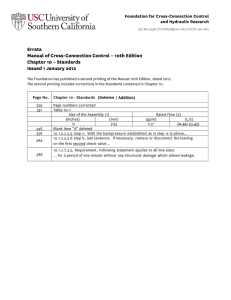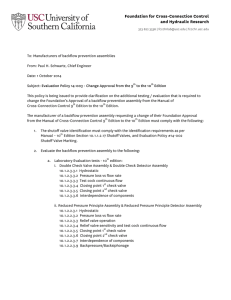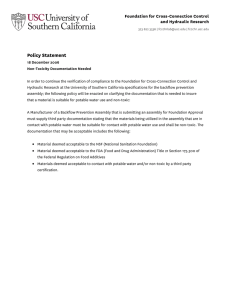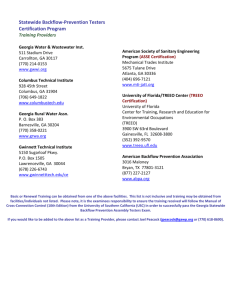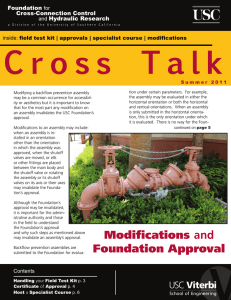Cross
advertisement
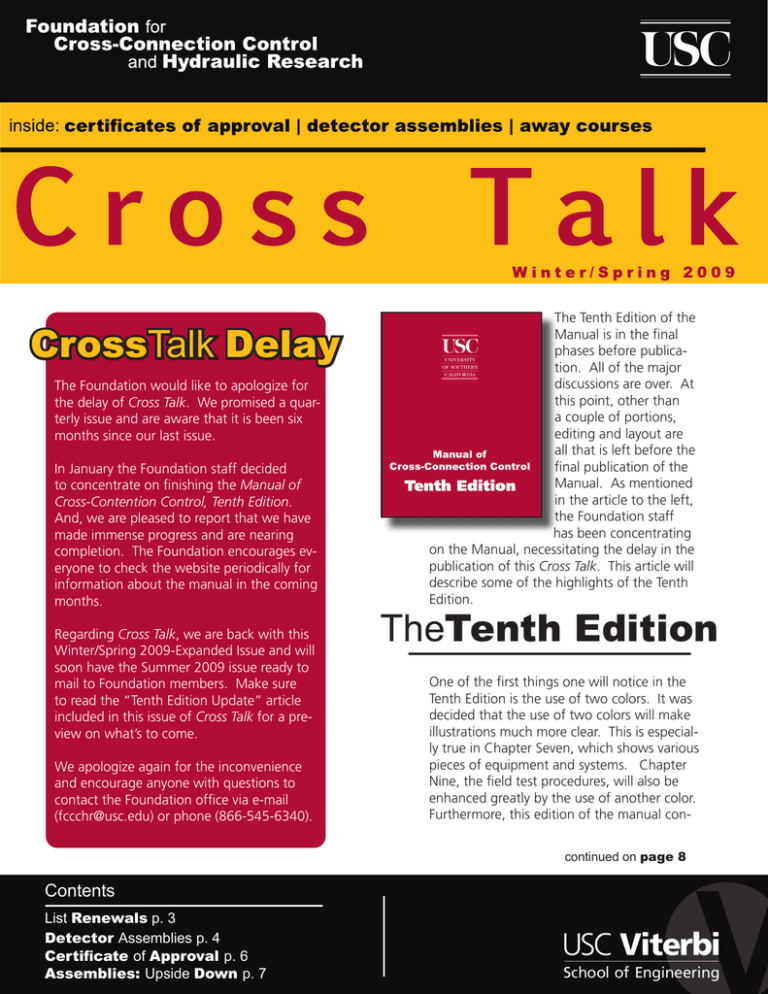
CrossTalk Delay The Foundation would like to apologize for the delay of Cross Talk. We promised a quarterly issue and are aware that it is been six months since our last issue. In January the Foundation staff decided to concentrate on finishing the Manual of Cross-Contention Control, Tenth Edition. And, we are pleased to report that we have made immense progress and are nearing completion. The Foundation encourages everyone to check the website periodically for information about the manual in the coming months. Regarding Cross Talk, we are back with this Winter/Spring 2009-Expanded Issue and will soon have the Summer 2009 issue ready to mail to Foundation members. Make sure to read the “Tenth Edition Update” article included in this issue of Cross Talk for a preview on what’s to come. We apologize again for the inconvenience and encourage anyone with questions to contact the Foundation office via e-mail (fccchr@usc.edu) or phone (866-545-6340). The Tenth Edition of the Manual is in the final phases before publication. All of the major discussions are over. At this point, other than a couple of portions, editing and layout are all that is left before the final publication of the Manual. As mentioned in the article to the left, the Foundation staff has been concentrating on the Manual, necessitating the delay in the publication of this Cross Talk. This article will describe some of the highlights of the Tenth Edition. TheTenth Edition One of the first things one will notice in the Tenth Edition is the use of two colors. It was decided that the use of two colors will make illustrations much more clear. This is especially true in Chapter Seven, which shows various pieces of equipment and systems. Chapter Nine, the field test procedures, will also be enhanced greatly by the use of another color. Furthermore, this edition of the manual concontinued on page 8 Contents List Renewals p. 3 Detector Assemblies p. 4 Certificate of Approval p. 6 Assemblies: Upside Down p. 7 Foundation Membership The Foundation’s Membership Program provides many benefits to the Members of the Foundation. These include: a twenty-five percent discount on manuals, twenty percent discount on Foundation Training Courses for ALL EMPLOYEES of the Member company/organization, the List of Approved Backflow Prevention Assemblies with access to the up-to-the-minute version on the Foundation’s website. Below is a list of those who have become members of the Foundation this past two quarters: American Plumbing Modesto, City of Arvin Community Services District Ohana Backflow Test & Repair Ascott Technologies, Inc. Okahara & Associates, Inc. Backflow Technology, LLC. Palm Ranch Irrigation District BackflowSIM Parsons Water & Infrastructure Bastrop I.S.D. Perk-A-Lawn, Inc. Boulder, City of PIMA Community College BPI Plumbing Princess Cruises California Curb and Landscape Professional Inspection Service California State Parks R.G.A. Rooter & Plumbing Cash Acme Ronald’s HVAC Co. Columbus, City of, Ohio RPZ Testing Services Cy Cooper Company Safe Flow LLC E.Z. Roth Plumbing, Inc. Scott Armour Elk Grove Water Service Sigma Water Safety, Inc. Fire Systems West, Inc. Stanford University Plumbing Shop Forney, City of-Public Works Tho’s Construction GOC Plumbering Tim H. Tutiakoff Jr. Hardin & Associates Consulting Village Backflow Prevention Service Indian Trial Plumbing Wally Koziol JDM Backflow Testing & Cert. Water Bridge Environmental Kettle Falls, City of West Coast Construction Services LeBlanc’s Plumbing Windsor, Town of M & M Handyman Services Cross Talk is published by the Foundation for Cross-Connection Control and Hydraulic Research at the University of Southern California for Foundation Members. 2009 © University of Southern California. All rights reserved. printed on Cross Talk WINTER-SPRING 2009 Page 2 recycled paper ListRenewals The List of Approved Backflow Prevention Assemblies is an essential tool for testers and cross-connection control specialists. The Foundation makes every effort to keep the list current with approved assemblies that meet the standards found in the Manual of Cross-Connection Control, Ninth Edition. One aspect of keeping the list relevant is following up with renewals of the assemblies. Every assembly that is approved by the Foundation must renew its listing every three years. The renewal process ensures that the assembly continues to meet the standard, under which it was first approved. Renewal is not automatic. The Foundation retains the right of determining the extent of re-evaluation required before renewal is granted. Aside from the manufacturer submitting to the Foundation the current sales, installation and maintenance literature of the assembly along with spare parts availability; the Foundation will look at the past performance of the assembly under field operating conditions. One way the Foundation accomplishes this task is by listening to feedback from members and the general public. complaint to give as much detail and information to the Foundation as possible in order to recreate the condition or investigate other similar situations. It is recommended that a detailed report of the problem be included, documenting the complaint, and the following information be noted to help aid the Foundation staff in their assessment; that information includes the affected assembly model and size along with the use of the assembly and some indication of conditions under which the assembly is operating. Additionally, any photographs that depict the problem are very helpful. Damaged, faulty or affected components could also be sent to the Foundation Laboratory for assessment. All this information will help the Foundation staff determine if a problem does exist. Feedback from members and the general public are crucial in helping the Foundation keep on top of any issues or problems that need to be addressed regarding approved assemblies. It is of extreme importance that the Foundation staff be given every piece of information available. If the conclusion of the investigation indicates that the complaint is valid, the Foundation will take the appropriate steps to contact the manufacturer and in some cases issue a Special Notice to make members of the Foundation aware of the problem. The Foundation receives complaints that vary from the aesthetics to the inner workings of a backflow prevention assembly. Once the complaint is brought to the attention of the Foundation, via e-mail, phone or in person, the Foundation staff records the complaint for further investigation. It is at this point that it is crucial for the person making the Finally, after the Foundation is satisfied that all the criteria for re-evaluation are met the assembly then is granted renewal. The latest List will reflect the current status of a particular model and size assembly. A reminder, all assemblies on the List are approved, it is not until they are removed from the List that it becomes an unapproved assembly. g Cross Talk WINTER-SPRING 2009 Page 3 DetectorAssemblies Backflow prevention assembly testers will, at some point in time, need to test double check detector assemblies and reduced pressure principle detector assemblies. The field test procedures for the detector assemblies are found in Section 9 of the Manual of CrossConnection Control, Ninth Edition. These will be in Chapter 9 of the Tenth Edition of the manual. In both editions of the manual the procedures require the tester to test the mainline assembly of the Reduced Pressure Principle Detector Assembly (RPDA) before testing the bypass. For the Double Check Detector Assembly (DCDA), the bypass assembly is tested before the main line assembly is tested. Many testers have enquired as to the reasoning for the order of the tests. This article will help the reader understand the reasoning of the Manual Review Committee in designating the order of these tests. Double Check Valve Assembly The manual requires the bypass assembly of the DCDA to be tested before the mainline assembly. If one first tests the mainline DC of the DCDA, the No.2 or downstream shutoff valve is closed and then the No.1 or upstream shutoff valve is closed. When the upstream shutoff valve is closed the pressure is cut off, Cross Talk WINTER-SPRING 2009 not only to the main line assembly, but also to the bypass assembly. As the test continues and pressure is dropped in the mainline assembly to ascertain the reading of the No.1 check valve. This also drops the pressure upstream of the No.1 check valve in the bypass assembly. The pressure, which should be captured in front of the mainline first check valve and recorded on the gage, may actually flow through the bypass DC. Remember, in order for the DCDA to detect unauthorized flow, the bypass DC must have check valve loadings (i.e., spring) that are less than the mainline DC. Water always wants to follow the path of least resistance. So the pressure in front of the mainline first check valve may flow through the bypass, providing a false reading for the mainline check valve. To prevent this from occurring, the bypass DC should be isolated from the mainline DC by closing the bypass shutoff valves. If the bypass DC needs to be closed first to make sure that accurate values are recorded for the mainline assembly, then it makes sense that the bypass DC is tested first and the bypass shutoff valves be left closed when proceeding to the mainline DC. Then the mainline DC can be tested without any possible influence from the bypass DC. When the bypass DC is tested first the mainline DC remains under normal operating conditions. Closing the shutoff valves on the bypass DC or depressurizing the assembly does not alter the condition of the mainline DC because the shutoff valves in the bypass arrangement isolate the bypass DC, while line pressure continues to supply the mainline DC. So, the most accurate way (and the designated method) of testing the DCDA is to test the bypass assembly first and then test the mainline DC. continued on page 5 Page 4 Reduced Pressure Principle Assembly The Manual requires that the mainline assembly of the RPDA be tested before the bypass assembly. The order of testing the components of the RPDA is not as critical as with the DCDA because both the mainline and bypass RPs remain under pressure during the entire procedure. So, testing one assembly first doesn’t alter the condition of the other assembly. However, the procedure needs to have one assembly tested before the other. The Manual Review Committee decided to require the mainline assembly to be tested first, simply because this is the main assembly and more critical to the protection of the potable water line (because of the amount of water flowing through it). This is the reasoning used by the Manual Review Committee in determining the order of testing of the DCs and RPs in the detector assemblies. g SPECIAL NOTICE All Foundation members recently received, via mail, the first special notice of the year. The Foundation publishes special notices from time to time. These notices contain information that requires special attention. Notice 09-001 notifies members that it has come to the attention of the Foundation that there are unapproved components distributed by third parties, which may be installed in some Febco pressure vacuum breaker assemblies. The notice addresses the model and size information affected along with illustrations of the correct bonnet and poppet assemblies for the Febco pressure vacuum breaker assemblies. The notice is available on the Foundation’s website (www.usc.edu/fccchr). Feel free to contact the Foundation via e-mail (fccchr@usc.edu) or phone (866-545-6340) for more information. g Cross Talk WINTER-SPRING 2009 Page 5 Certificate of Approval The Foundation’s approval process consists of a laboratory and field evaluation. After successfully completing the process, the backflow prevention assembly is added to the List of Approved Backflow Prevention Assemblies and the manufacturer is issued a certificate of approval from the Foundation. That certificate of approval has created some confusion among administrative authorities and customers. The certificate of approval is issued on the date the assembly is added on the List. Following the initial approval all assemblies on the List are subject to renewal every three years. And, if granted, the renewal date appears on the List in the column titled renewed. However, the Foundation does not print out new certificates of approval each time an existing assembly is renewed. It has come to the attention of the Foundation that some may use the certificate of approval date to mislead customers into believing that a more recent approval means a superior assembly. Unfortunately, a number of people have used the certificate of approval as a marketing ploy by referring to their competitor’s product as having an “old” approval. For example, since the certificate is only printed once, a manufacturer that had an assembly approved back in May 1997 has a certificate with that date. But, that assembly may have gone through many successful renewals and continues to appear on the List as an approved assembly. Yet, the manufacturer only has a certificate stating the May 1997 date. Therefore, to the misinformed it might seem at first glance that the approval is “old.” Administrative authorities that are not Foundation members or do not have access to the List may be misled to believe that an older date on a certificate of approval means that the product is in some way not as capable as a more recently approved assembly. This conclusion is absolutely false. As long as the assembly continues to appear on the List it is approved. Since the Foundation does not print renewal certificates, a manufacturer may only have a certificate from its initial approval 10,15 or 20 years ago. But, that does not mean the assembly is inferior to an assembly that was approved a month ago. However, it may be that an assembly that was originally approved some years ago was approved under the Eighth Edition of the Manual or even an earlier edition. In this case, it is important to note that the standard under which the assembly was approved is different than the current standard. Although an assembly approved under an earlier edition of the manual is still approved, it was approved under a previous standard. So, it may or may not meet the standard published in the current edition of the manual. If you have any questions concerning the approval of an assembly the Foundation office is available via e-mail (fccchr@usc.edu) or phone (866-545-6340). g Cross Talk WINTER-SPRING 2009 Page 6 Assemblies: UpsideDown Backflow prevention assemblies may be installed in different orientations. For example, an assembly may be installed in the horizontal or vertical orientation. Recently, the Foundation received an enquiry about rotating an assembly on its axis 180 degrees (upside-down) and maintaining its Foundation approval. With several possibilities for assembly installation orientations, the Foundation must approve assemblies in a specific orientations to ensure the assembly meets the standards set forth in the Manual of Cross-Connection Control, Ninth Edition. Therefore, the Foundation includes an orientation key with the List of Approved Backflow Prevention Assemblies. The current Standard found in the Manual of Cross-Connection Control, Ninth Edition requires that the identification tag be either on the top of the assembly or on both sides. Consequently, turning an assembly upside-down would mean that the identification tag would be found at the bottom of the assembly. Other concerns include rotating gate valves upside-down and potentially having the bonnets of the valves fill up with debris preventing the shutoff valves from fully opening. Currently, no assembly is approved upsidedown. And, even though rotating the assembly upside-down may or may not affect its ability to prevent backflow the assembly must be submitted and tested before being approved by the Foundation in that orientation. It is the manufacturer’s discretion as to what orientation their assembly will be submitted for approval to the Foundation. Once the assembly is approved in a specific orientation that notation is made on the ‘orientation’ column found on the List. Feel free to contact the Foundation office about assembly orientation via e-mail (fccchr@usc.edu) or phone (866-545-6340). g Cross Talk WINTER-SPRING 2009 Page 7 TheTenth Edition: continued continued from page 1 tains a CD-ROM. Several items, like sample forms, an ordinance and a list of incidents, are included on this CD in MS Word, MS Excel, or Adobe Acrobat format. the pressure vacuum breaker assembly with the additional explanation of the operation of the air inlet valve. The spill-resistant vacuum breaker assembly is also included. Some specific highlights of the manual follow. Chapter 4, titled Elements of a Program, lays out the desired elements of a cross-connection control program: Authority, Backflow Preventers, Certified Testers and Specialists, Defensible and Detailed Records and Education and Training. The chapter then discusses policies and procedures to help the cross-connection control administrator in the day-today operations of a cross-connection control program. Some of the policies discussed are: Change of Occupancy, Dual Services, Existing Assemblies, Non-Compliance, etc. Chapter 3, titled Hydraulics, is completely new to the Manual. This chapter covers an introduction to hydraulics, detailing pressures, flow and the general characteristics of water in various pressure conditions. What backflow is, the different types of backflow and how it occurs. Examples of backflow situations are given: how the hydraulics are involved, the connections necessary for a backflow incident to occur, etc. Chapter 3 also covers details of the operation of each of the backflow preventers. It begins with describing how a check valve works and then continues to describe a double check valve assembly. Building on this, the details of differential pressure relief valve is added to explain the operation of the reduced pressure principle assembly. The same is done with Cross Talk WINTER-SPRING 2009 Chapter 6, Facilities, breaks up facilities into major categories. Each category lists expected pieces of equipment that are likely to exist at these facilities. This enables the administrative authority to prepare effectively for a cross-connection control survey. For example, if a site survey is to be conducted at a cannery, the Specialist would look under Page 8 the category of “Food Processing/Service.” This section lists some of the water using equipment that one might expect to find at such a facility. Several pieces of equipment are illustrated in Chapter 7. The equipment is described and the questions, “How does it work?” and “Where is it used?” are answered. needle valve gauge format only. However, for those steps, where there is a difference in the procedure when a different style gauge is used, an inset is included showing how both the two needle valve gauge and the three needle valve gauge are to be attached. Chapter 8 contains samples and forms. This gives the Specialist examples of letters, and forms that may be used in the crossconnection control program. Most of these are included in either a MS Word format, or Adobe Acrobat format on the CD that will be included with the manual. Chapter 9 will cover the field test procedures. There are some changes to these procedures. As with the Ninth Edition, each step of the field test procedures is illustrated. Additionally, complete illustrated RP procedures are included for a five needle valve gauge, a three needle valve gauge and a two needle valve gauge. The double check valve assembly, pressure vacuum breaker and spill resistant vacuum breaker include the five Chapter 10 includes the standards. There are some changes to the standard for backflow prevention assemblies, but the point of most interest is that Chapter 10 includes a standard for field test kits. Once the Tenth Edition is published, manufacturers of field test kits may submit them to the Foundation to begin the approval process. Once field test kits are approved, the Foundation will publish a List of Approved Field Test Kits. Chapter 11 includes the backflow incidents for which the Foundation has documentation. This list has grown substantially since the publication of the Ninth Edition, and a sortable Excel version will be included on the manual’s CD. Cross Talk continued on page 11 WINTER-SPRING 2009 Page 9 Away SpecialistCourse The Foundation is enthusiastic to announce that its Course for the Training of Cross-Connection Control Program Specialist will be returning to the state of Louisiana next spring. The course is scheduled for the 8-12 of February in Baton Rouge. Following a successful course last March the state has asked the Foundation staff to return for another training course. The Course for the Training of Cross-Connection Control Program Specialists is designed to train those who might be involved in administering a cross-connection control program. Subjects covered in this course include: policies and procedures, rules and regulations, record keeping, public relations, plan checks and site surveys. Registration is currently open. You may visit the Foundation’s website (www.usc.edu/fccchr) to register online or you may contact the Foundation office (866-545-6340) for more information. Found Cross ation for and Hy-Connectio n drauli c Res Control earch Specia list Tra Course ining Baton 8-12 F Rouge, LA ebrua ry 201 0 Subjects co in this co vered urse inclu de: • Polic ies/ Proc • Rule edures s/ • Reco Regulations rd Keep • Publ ing ic • Plan Relations Checks • Surv eys The cour se is idea for a cr l for th os ose resp their ar s-connection onsible cont ea utility pe . Students typi rol program in cally in rs clu those fro onnel, health agency de water m large pe private w rsonne ater-usin contract l, g faciliti ors. es and contact us at 866www.u 545-6340 sc.edu /fcc chr If you are interested in hosting a course please visit the Foundation’s website and click on the ‘Frequently Requested Documents’ link found on the homepage to learn how to bring a training course to your area. g New Price Essentials of Cross-Connection Control Many in the cross-connection control industry use the Foundation’s training tools, and we are happy to announce that the Essentials of Cross-Connection Control will be available to members for $25. The Essentials of Cross-Connection Control slide presentation includes a CD-ROM with the presentation in Microsoft PowerPoint format and a printed booklet insert that contains a brief description of each slide. The slides cover some basic hydraulics and definitions of the various terms such as backflow, backpressure, backsiphonage, cross-connection, etc. Graphics for the following acceptable means of backflow prevention (the air-gap, the reduced pressure principle backflow assembly, the double check valve assembly, the pressure vacuum breaker assembly, and the atmospheric vacuum breaker assembly) are shown rendered in 3-D for greater detail. The proper applications of each of the backflow preventers are shown as related to the hydraulic condition of the installation and the degree of hazard. The slide presentation may be previewed on the Foundation’s website. You may order the Essentials slide presentation from the Foundation’s website (www.usc.edu/fccchr) or via phone (866-545-6340) by contacting the Foundation’s office. g Cross Talk WINTER-SPRING 2009 Page 10 WTFSW VHS Video ONLY $8.00 Following the Foundation’s transition from VHS to DVD for its training videos, the Foundation has a supply of VHS tapes of the video Working Together for Safe Water leftover. Therefore, effective immediately, all members will be eligible to purchase the Working Together for Safe Water VHS tape for $8.00. THIS APPLIES ONLY TO THE VHS VERSION OF THE VIDEO. In addition to the special member only price, the Foundation will ship all orders of the VHS tape free of charge via FedEx Ground. A faster delivery service is available at the customer’s expense. The fifteen-minute video is ideal as an introduction to cross-connection control for agency employees, city councils, students or the water consumer who may not understand the necessity for backflow protection on their premises. The video explains how backflow can occur and how crossconnections can be controlled with various types of backflow prevention assemblies. It also discusses some of the aspects of an effective cross-connection control program. Also, the Foundation regularly receives requests for broadcasting Working Together for Safe Water on local cable television. Using the video on local access television stations to educate the public on backflow prevention is an effective way to communicate this important information to the public. The Foundation is more than happy to comply with any requests it receives concerning broadcasting the video Working Together for Safe Water. The Foundation asks that a written request from the sponsoring agency be mailed to the Foundation office. To purchase the video you may visit the Foundation’s website (www.usc.edu/fccchr) or contact the Foundation office via phone (866-545-6340). g TheTenth Edition continued from page 9 Some other items included in the Tenth Edition include a history of cross-connection control and backflow prevention and guidelines for conducting a cross-connection control survey. The Manual Review Committee has overcome all of the major delays that have slowed down the publication of the Tenth Edition. There are still some final details to be completed, but there are no major decisions left to be made. Therefore, the process has accelerated greatly and we can expect to see the Tenth Edition delivered this fall. g Cross Talk WINTER-SPRING 2009 Page 11 Training Courses Tester Course Los Angeles, CA 19-23 October 2009 Los Angeles, CA 25-29 January 2010 Specialist Course Los Angeles, CA 27-31 July 2009 Los Angeles, CA 4-8 January 2010 Baton Rouge, LA 8-12 February 2010 Upcoming Events NCBPA Annual Product Show and BBQ Pleasanton, CA 27 August 2009 Inland County Backflow Prevention San Bernardino, CA 9 September 2009 2009 Western Regional Backflow Conference Las Vegas, NV 5-6 October 2009 Contact Information Phone: 866-545-6340 Fax: 213-740-8399 E-mail: fccchr@usc.edu Website: www.usc.edu/fccchr Foundation for Cross-Connection Control and Hydraulic Research University of Southern California Kaprielian Hall 200 3620 South Vermont Avenue Los Angeles, California 90089-2531 First Class US Postage PAID University of Southern California
